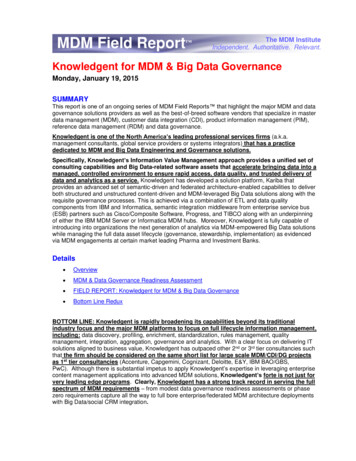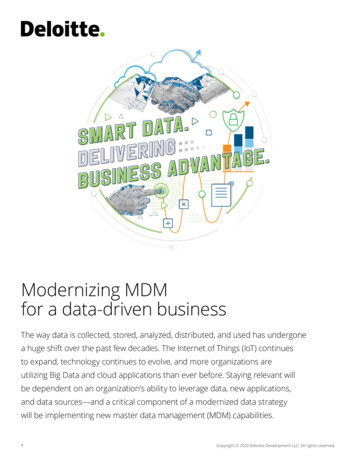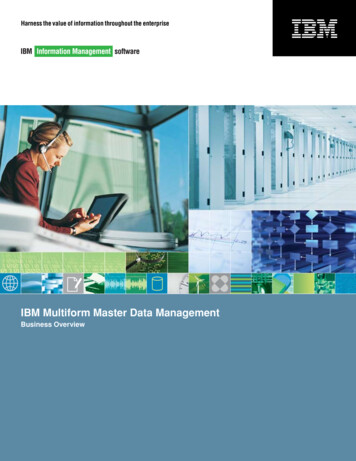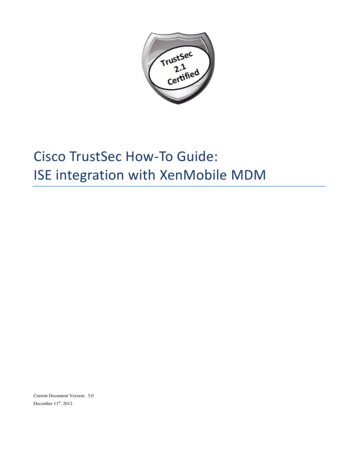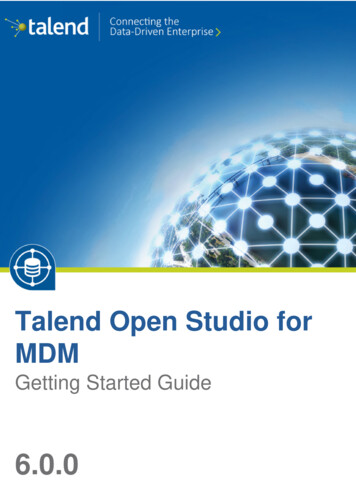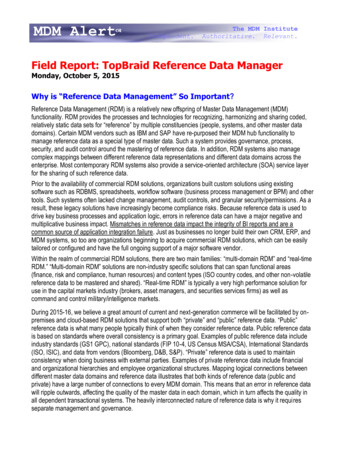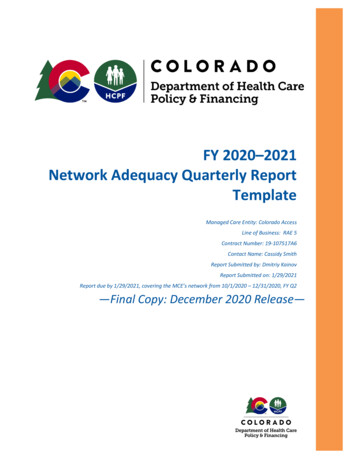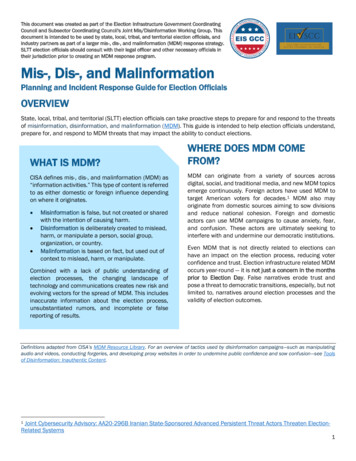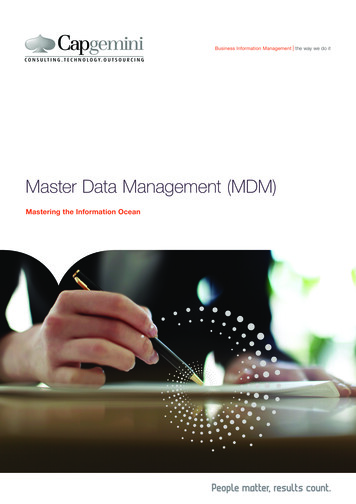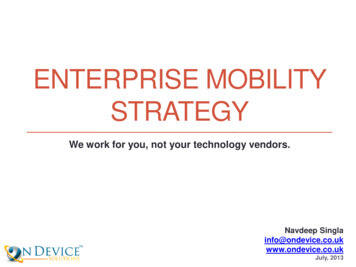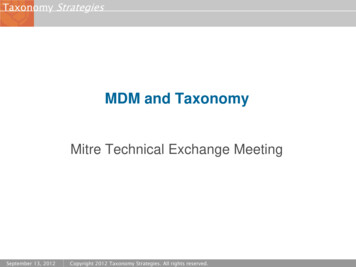
Transcription
Taxonomy StrategiesMDM and TaxonomyMitre Technical Exchange MeetingSeptember 13, 2012Copyright 2012 Taxonomy Strategies. All rights reserved.
Interoperability The ability of diverse systems and organizations to worktogether by exchanging information. Semantic interoperability is the ability to automatically interpret theinformation exchanged meaningfully and accurately.Taxonomy Strategies The business of organized information2
Interoperability ROI Information assets are expensive to create so it’s critical that they canInfo Asset Costbe found, so they can be used and re-used. Every re-use decreases the information asset creation cost andincreases the information asset value.12345678910Info Asset UsesTaxonomy Strategies The business of organized information3
Interoperability ROI (2) If information assets are so important, why can’t they be found? They are named in different ways. There is no metadata, or the metadata is incomplete and inconsistent. There is no searchable text (data, graphics, visualizations, etc.) They exists in different applications, file shares and/or desktops. They have been discarded or lost. When they are found why can’t information assets be reused? There are no authoritative sources. When there are multiple versions, it’s difficult to choose which one touse. The source, accuracy and/or authority are unclear. The usage rights may not be clear.Taxonomy Strategies The business of organized information4
Interoperability ROI (3) Information assets are sourced from multiple applications andlocations Product lifecycle management (PLM) application Product information management (PIM) application Enterprise content management system application Third party contractors’ systems Another department or agencyTaxonomy Strategies The business of organized information5
Interoperability vision I want to easily find any information assets in a particular format thatcan be used for a specific purpose regardless of where they arelocated. I want an authoritative source for key named entity* data such as“customer” or “product”.* Named entities - people, organizations, locations, events, things, etc.Taxonomy Strategies The business of organized information6
Agenda Problems with metadata Two types of vocabularies Business intelligence tools requirementsTaxonomy Strategies The business of organized information7
Problems with data and metadata Inconsistent category assignments CA vs. California RiM vs. Research in Motion Changes to classification systems over time ICD-9 vs. ICD-10 SIC vs. NAICS Use of multiple overlapping or different categorization schemes States vs. SMSA’s ICD-9 vs. CDC Diseases and Conditions NASA Taxonomy vs. NASA ThesaurusTaxonomy Strategies The business of organized information8
Case Study: Inconsistent categories (1)Problem: Inaccurate reporting with incorrect product counts at global healthand beauty products company. Some SKUs are sold as units, as well as a part of a kit, a set and/or abill of materials. Lacked a consistent, standard language to enable data sharingincluding: Rules for SKUs. Business processes related to product data. Product data definitions. Single owner for data elements. Roles and responsibilities related to product data. Product data integration points and relationships.Taxonomy Strategies The business of organized information9
Case Study: Inconsistent categories (2)Solution: Faceted SKU taxonomy instead of a single, monolithic taxonomy tree More flexible design. Describe every item with a combination of facets. Focus on universal facets applied to all products, or to all productswithin a large grouping such as a product line. Provides the basis for MDM entity resolution.Taxonomy Strategies The business of organized information10
Case Study: Inconsistent categories (3)Universal facets/entitiesDistinguishes products that arespecifically intended for one ormore age groups.Distinguishes betweenproducts for women andproducts for men.Regions and locales withinregions that identifytarget markets or businessregions.Short description of theproduct.Indicates type of measure such asnumber of items, or fluid ounces ormilliliters.Taxonomy Strategies The business of organized informationMajor grouping of products basedon lines of business. A SKU can bein one or more product lines.A single product or family ofproducts with a distinct,copywrited, and sometimestrademarked label.Broad, generic categoriesused to organize andgroup products formerchandising and/orbusiness purposes.A key, active ingredient thatis part of the formulationthat yields the desiredeffect in the product.Indicates whether a product iscomposed of one or multiple SKUs.If the product is a kit, set or customassembled BOM, then thecomponent SKUs need to beidentified.11
Case Study: Multiple categorization schemes (1)Problem: Need to promote agency behavioral health program toheterogeneous audiences: Human services professionals Concerned family Policy makers Merge heterogeneous information sources: Alcohol and drug information Mental health information Other agency and inter-agency resources– Drug Abuse Warning Network (DAWN)– Treatment Episode Data Set (TEDS)– Uniform Reporting System (URS)Taxonomy Strategies The business of organized information12
Case Study: Multiple categorization schemes (2)Solution: Faceted taxonomy identifies and resolves key named entities Powers the SAMHSA Store as illustrated in a YouTube video. Provides framework for agency key performance indicators. Increases the availability and visibility of SAMHSA information. Offers tools for analysis, visualization and mash ups with other sources.Taxonomy Strategies The business of organized information13
Case Study: Multiple categorization schemes (3)SAMHSA Store Taxonomy facetsTaxonomy Strategies The business of organized information14
Case Study: Multiple categorization schemes (4)Taxonomy Strategies The business of organized information15
Case Study: Multiple categorization schemes (5)SAMHSA Info ToolsTaxonomy Strategies The business of organized information16
MDM vs. Taxonomy Taxonomy aims to standardize metadata values and the relationshipsbetween them Especially term strings. Taxonomy can act as a precursor to MDM in that it helpsorganizations understand what data to master and how to organizethis data. MDM aims to normalize metadata schemas and valid values acrossheterogeneous data management systems.Taxonomy Strategies The business of organized information17
Agenda Problems with metadata Two types of vocabularies Business intelligence tools requirementsTaxonomy Strategies The business of organized information18
MDM is concerned with two types of vocabularies Concept schemes – metadata schemes like Dublin Core, STEP(Standard for the Exchange of Product Model Data) and SEMI E36(Semiconductor Equipment and Materials International) Semantic schemes – value vocabularies like taxonomies, thesauri,ontologies, etc.Taxonomy Strategies The business of organized information19
What is Dublin Core? Provides the basis for any user, tool, or program to find and use anyComplexityinformation asset.Subject metadata –What, Where & Why:Subject, Type, CoverageUse metadata –When & How:Date, Language, RightsAsset metadata – Who:Identifier, Creator, Title,Description, Publisher,Format, ContributorRelational metadata –Links between and to:Source, RelationEnabled Functionalityhttp://dublincore.org/Taxonomy Strategies The business of organized information20
DCAM (Dublin Core Abstract Model) SingaporeFrameworkDeclares which elements fromwhich namespaces are used in aparticular application or project.Taxonomy Strategies The business of organized information21
Why Dublin Core?According to R. Todd Stephens* Dublin Core is a de-facto standard across many other systems andstandards RSS (1.0), OAI (Open Archives Initiative), SEMI E36, etc. Inside organizations – ECMS, SharePoint, etc. Federal public websites (to comply with OMB Circular tegorize/meta-data) Mapping to DC elements from most existing schemes is simple. Metadata already exists in enterprise applications Windchill, OpenText, MarkLogic, SAP, Documentum, MS Office,SharePoint, Drupal, etc.* Sr. Technical Architect (Collaboration and Online Services) at AT&TTaxonomy Strategies The business of organized information22
Semantic Schemes: Simple to ComplexA system for identifying andnaming things, and arranging theminto a classification according to aset of rules.A set of words/phrases that can beused interchangeably forsearching. E.g., Hypertension, Highblood pressure.An arrangement of knowledgeusually enumerated, that does notfollow taxonomy rules. E.g., DeweyDecimal Classification.Semantic SchemesEquivalenceHierarchyA list of preferred and variantterms.RelationshipsA faceted taxonomy but uses richersemantic relationships amongterms and attributes and strictspecification rules.AssociativeA tool that controls synonyms andidentifies the semanticrelationships among terms.After: Amy Warner. Metadata and Taxonomies for a More Flexible InformationArchitectureTaxonomy Strategies The business of organized information23
Q: How do you share a vocabulary across (and outsideof) the enterprise?A: With standards ANSI/NISO Z39.19-2005 Guidelines for the Construction, Format, andManagement of Monolingual Controlled Vocabularies ISO 2788:1986 Guidelines for the Establishment and Development ofMonolingual Thesauri ISO 5964:1985 Guidelines for the Establishment and Development ofMultilingual Thesauri ISO 25964 (combines 2788 and 5964) Thesauri and Interoperabilitywith other Vocabularies Zthes specifications for thesaurus representation, access andnavigation W3C SKOS Simple Knowledge Organization SystemTaxonomy Strategies The business of organized information24
Why SKOS?According to Alistair Miles* (SKOS co-author) Ease of combination with other standards Vocabularies are used in great variety of contexts.– E.g., databases, faceted navigation, website browsing, linked open data,spellcheckers, etc. Vocabularies are re-used in combination with other vocabularies.– E.g., ISO3166 country codes USAID regions; USPS zip codes USCongressional districts; USPS states EPA regions, etc. Flexibility and extensibility to cope with variations in structure andstyle Variations between types of vocabularies– E.g., list vs. classification scheme Variations within types of vocabularies– E.g., Z39.19-2005 monolingual controlled vocabularies and the NASATaxonomy* Senior Computing Officer at Oxford UniversityTaxonomy Strategies The business of organized information25
Why SKOS? (2) Publish managed vocabularies so they can readily be consumedby applications Identify the concepts– What are the named entities? Describe the relationships– Labels, definitions and other properties Publish the data– Convert data structure to standard format– Put files on an http server (or load statements into an RDF server) Ease of integration with external applications Use web services to use or link to a published concept, or to one or moreentire vocabularies.– E.g., Google maps API, NY Times article search API, Linked open data A W3C standard like HTML, CSS, XML and RDF, RDFS, andOWLTaxonomy Strategies The business of organized information26
MDM model that integrates taxonomy and reSource: Todd Stephens, BellSouthPer-Source Data Types,Access Controls, etc.Taxonomy Strategies The business of organized information27
Agenda Problems with metadata Two types of vocabularies Business intelligence tools requirementsTaxonomy Strategies The business of organized information28
Business intelligence tools requirements Requirements for integrating taxonomy with business intelligencemetadata tools.Taxonomy Strategies The business of organized information29
Tools Taxonomy editing Data Harmony, Mondeca, MultiTes, PoolParty, protégé, SmartLogic,Synaptica, Top Braid Composer Metadata tagging (automated categorization) CIS, ConceptSearching, Data Harmony, MetaTagger, nStein, Smartlogic,temis Enterprise content management Alfresco, EMC Documentum, Drupal, IBM FileNet, Joomla!, OpenText,Oracle Content Management, SharePoint Business intelligence tools Actuate, Business Objects (SAP), Cognos (IBM), Hyperion (Oracle),Informatica, MicroStrategy, SASTaxonomy Strategies The business of organized information30
Taxonomy tool functions (1)Functional areaFunctionsTaxonomy DevelopmentCreate a taxonomyUser roles and permissionsTaxonomy MaintenanceAdd, edit, move, delete itemsAssign or modify privileges to one or a group of itemsActivity loggingTaxonomy GovernanceApproval workflow for additions and changesMetadata ControlledVocabularyAssign attributes to a categoryAssociate controlled vocabulary with metadata fieldThesaurus capabilitiesUser InterfaceSearch and browseDrag and dropMultiple windowsReportingAlphabetical, hierarchical and other viewsVisualizationsImporting and exporting taxonomiesApplication IntegrationAPIs (WSDL, Scripts, Java, etc.)Application integration (CMS, DMS, search engine, etc.)Taxonomy Strategies The business of organized information31
Taxonomy tool functions (2)Functional areaFunctionsDatabase DefinitionHow is the database created? Where is it stored? Is it Z39.19 and ISO2788 compliant? Database license requirement?Importing/Exporting DataHow are data imported? What file formats are supported? Can datafiles be in batches?Add, Edit, Delete CategoriesHow easily are categories added, edited, or deleted? Can categories beadded, edited, or deleted in batches?Relationship TypesHow are relationship types defined? What types are supported? Howis polyhierarchy handled?Add, Edit, DeleteRelationshipsHow easily are relationships added, edited, or deleted? Canrelationships be added, edited, or deleted in batches? Does a changepropagate to all instances?ReportingHow does the TMS report: new, edited, deleted taxonomies andcategories; new, edited, deleted relationship types and relationships;mapped taxonomies and categories? How are the reports presented?What audit logs are available? Can changes be traced to users whosuggested them? Is an “approval” step for changes available foradministrators?User AccessCan the TMS integrate user accounts with existing authenticationsystems, e.g. Active Directory, etc.? Is there support for role-basedaccess or defined group membership with configurable access? Is therea workflow to approve changes? What functionality is available orrestricted based on a user’s security privileges?Taxonomy Strategies The business of organized information32
Taxonomy tools and business intelligence No taxonomy tool vendors have connectors, custom APIs or otherdirect integrations with leading business intelligence tools. SAS acquired Teragram in 2010. Teragram is primarily an OEM business, not integrated with SASbusiness intelligence products. Business Objects acquired Inxight in 2007, which was acquired bySAP in 2008. Inxight is not evident in SAP business intelligence products.Taxonomy Strategies The business of organized information34
Taxonomy StrategiesQuestionsJoseph A Buschjbusch@taxonomystrategies.commobile 415-377-7912September 13, 2012Copyright 2012 Taxonomy Strategies. All rights reserved.
Provides the basis for MDM entity resolution. Taxonomy Strategies The business of organized information 11 Case Study: Inconsistent categories (3) . Business Objects (SAP), Cognos (IBM), Hyperion (Oracle), Informatica, MicroStrategy, SAS . Taxonomy Strategies The business of organized information 31 Taxonomy tool functions (1) Functional area .
